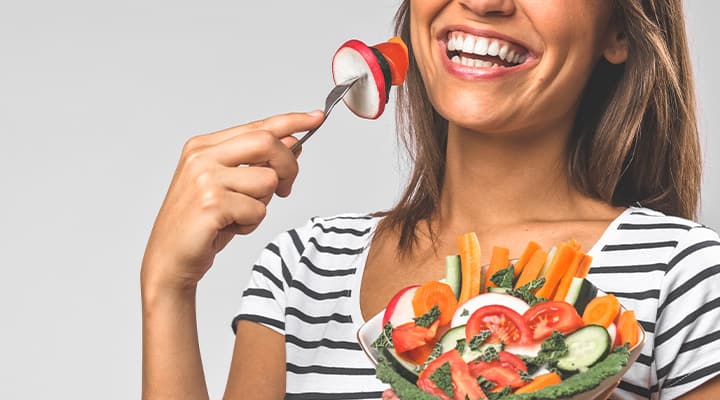
Best Cruciferous Vegetables For Breast Health
Published: September 2021
Is there a connection between broccoli and breast health? If you've heard it whispered that eating these little green tree-shaped vegetables—as well cabbage, Brussels sprouts, watercress and other cruciferous produce—helps ward off breast cancer, you can believe your ears. This is not an old wives' tale, nor is it an urban legend.
In fact, a 2021 article published in Anti-Cancer Agents in Medicinal Chemistry, which looked at multiple studies (human, animal and in vitro), concluded that eating adequate amounts of cruciferous vegetables could help protect against breast cancer.
Here's everything you need to know about these bitter-but-beneficial veggies—and which ones are best at fighting breast cancer.
What are cruciferous vegetables?

The term "cruciferous" is derived from the word "crucifer," which means, in plainer English, "cross." That's because many cruciferous vegetables have four-petaled flowers. For example, popular vegetables like broccoli, cauliflower, and cabbage all fit this unique botanical pattern.
In addition, some root vegetables, such as turnips and rutabaga, are also classified cruciferous; collard and mustard greens, Brussels sprouts, rapini and bok choy are also great cruciferous options.
If you like to switch up what's in your salad bowl, there are many cruciferous vegetables to choose from, including arugula, kale and chard. And let's not forget opportunities to season your food with cruciferous vegetables: spicy horseradish and wasabi not only offer the health benefits of other cruciferous vegetables, but they are the perfect antidote to bland cooking!
Why are cancer researchers studying cruciferous vegetables?
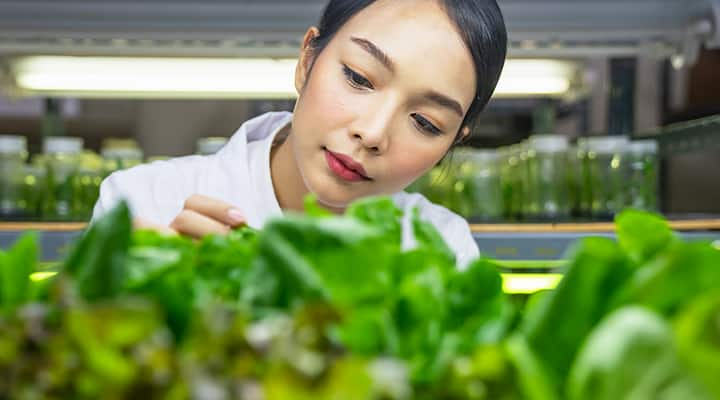
The scientific community’s interest in cruciferous vegetables surged after the publication of a 1994 Johns Hopkins University study, which found that rats given sulforaphane, a nutrient in cruciferous vegetables, developed 39% fewer tumors than the rats in a control group; all of the rodents had been exposed to a cancer-inducing chemical.
A whirlwind of additional studies followed, many of which showed that sulforaphane, in addition to another nutrient found in cruciferous vegetables called diindolylmethane (or DIM), significantly reduced the growth of a variety of different types of cancers, including breast cancer, but also bladder and brain cancer, leukemia, and more.
How do cruciferous vegetables fight cancer?
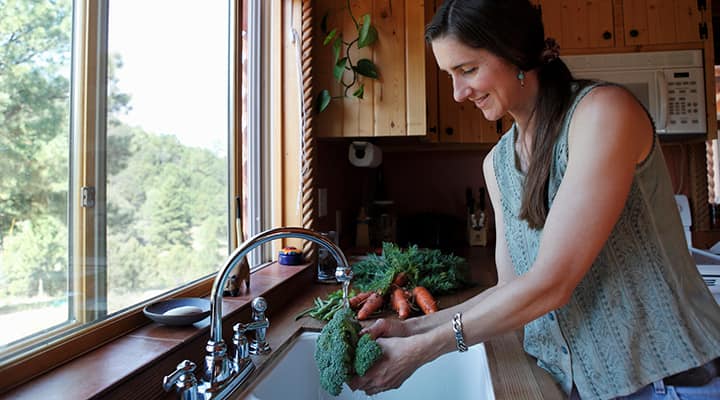
You've probably noticed a pungent odor many cruciferous vegetables emit when they're cut or cooked—that smell is caused by sulfur-containing substances called glucosinolates, which also give these veggies their bitter flavor. As you chew and digest your vegetables, the glucosinates get broken down into bioactively active compounds (meaning, the part of your food that impacts your bodily functions), such as indoles, nitriles, thiocyanates and isothiocyanates.
Several of these compounds have been shown in multiple rodent studies to inhibit the spread of cancer: sulforaphane, an isothiocyanate which, of course, protected those Johns Hopkins rats from tumors and indole-3-carbinol (I3C), which is metabolized into the aforementioned DIM.
In mice and rats, these compounds have been shown to fight cancer in several ways:
- They protect cells from DNA damage
- They can inactivate carcinogens
- They can even stop cancer cells from spreading!
What about studies in humans showing such benefits? While we don't have this level of evidence yet, there is an abundance of research showing that populations who consume more cruciferous vegetables are less likely to have breast cancer, and the evidence suggests that these compounds are the reason why. In 2018, example, researchers in China found that people who regularly ate cruciferous vegetables had a lower risk of breast cancer.
The top 4 healthiest cruciferous vegetables

Broccoli, cabbage, watercress and Brussels sprouts are the cruciferous vegetables people turn to most frequently when seeking out the benefits of cruciferous vegetables. Here's what makes them so healthy:
- Rich sources of multiple vitamins: Each serving offers an abundance of vitamin A, folic acid, vitamin E, and vitamin C—in fact, broccoli in particular contains more than 50 mg of vitamin C per 100 grams of weight.
- High in fiber, iron, calcium, magnesium and other nutrients: Even without their status as cancer-fighting vegetables, broccoli, cabbage, watercress, Brussels sprouts and other similar veggies are most certainly "superfoods" because of their nutritional profile.
- High in protein: You might not think of vegetables as a good source of protein—usually, that honor is reserved for meats, eggs and legumes—but these veggies have more than 1.5 grams of protein per serving. In fact, watercress packs in 3 grams.
That being said, if you prefer kale to cabbage or arugula to watercress, any vegetable that's been labeled "cruciferous" is likely to have very similar health benefits. For example, you might have noticed that if it weren't for their colors, broccoli and cauliflower are pretty much identical, and their health benefits are "twinning," too (aside from broccoli having a bit more vitamin C and K).
This is important to keep in mind, because if you don't love broccoli, eating cauliflower is a perfectly fine alternative. Clever dishes like "cauliflower mashed" (which tastes a little like mashed potatoes) or cauliflower crust pizza are a good option for people who don't love green veggies.
Can broccoli help prevent breast cancer?

Broccoli contains beneficial compounds that have been shown to reduce the risk of cancer—all forms of it, including breast cancer. That's because sulforaphane and DIM have demonstrated anticancer effects in virtually every kind of tissue studied.
Are there other ways that broccoli (and other cruciferous vegetables) specifically fight breast cancer? Yes! It all comes down to estrogen balance. There is a type of estrogen called 16-alpha hydroxyestrone that drives the growth of breast cancer cells, and another type of estrogen, called 2-hydroxyestrone, which stops breast cancer cells from proliferating. The broccoli compound DIM may increase the balance of 2-hydroxyestrone—in fact, in a study of women with breast cancer, increasing daily intake of DIM resulted in healthier estrogen balances.
If you want to reduce the risk of breast cancer in future generations, it might help to eat plenty of cruciferous vegetables while you're pregnant! A preclinical study in mice found that pregnant and lactating mothers who had a high intake of broccoli sprouts had offspring with a lower incidence of breast cancer. (Again—this is research in animals and not humans, but for a variety of reasons, it can't hurt to switch those pickles and ice cream binges for a broccoli buddha bowl!)
Is cabbage good for breast cancer?
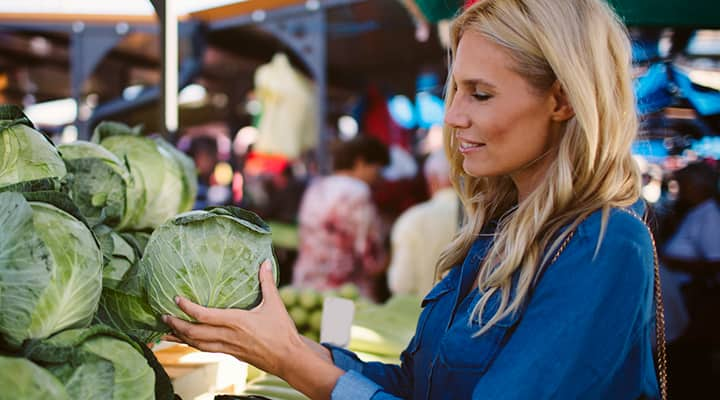
Cabbage and other vegetables in the cabbage family, like Chinese and red cabbage and bok choy, are must-haves for your breast cancer prevention grocery list, and they are also important foods for breast cancer patients to eat regularly. That's because this cruciferous vegetable has been linked to breast cancer prevention, protection against DNA damage, and it can even help certain breast cancer treatments work better.
The breast health-promoting compounds found in vegetables in the cabbage family include:
- I3C and its metabolic product DIM
- Sulforaphane
- Beta-carotene—women with high intake of this vegetable have a lower incidence of breast cancer
- The natural red pigments in red cabbage, and apigenin in Chinese cabbage and boy choy, have been shown to slow the growth of breast cancer cells
Raw Cabbage Juice: A Healthy Recipe

You'll get the maximum cancer-fighting benefits from cabbage if you eat it raw—but let's be honest! That's not always easy to do.
Fortunately, juicing cabbage is a great way to get the benefits of raw cabbage without the harsh taste or tough-to-chew texture.
The key is to add in something sweet, like an apple or carrots, to cut the bitterness. Grab your juicer and give this recipe a try:
- 4 cabbage heads, raw with stems removed
- One apple (green for a tarter taste; red for sweetness)
- A dash of cinnamon
After juicing, consume immediately for maximum benefits!
Is it safe to eat cruciferous vegetables every day?
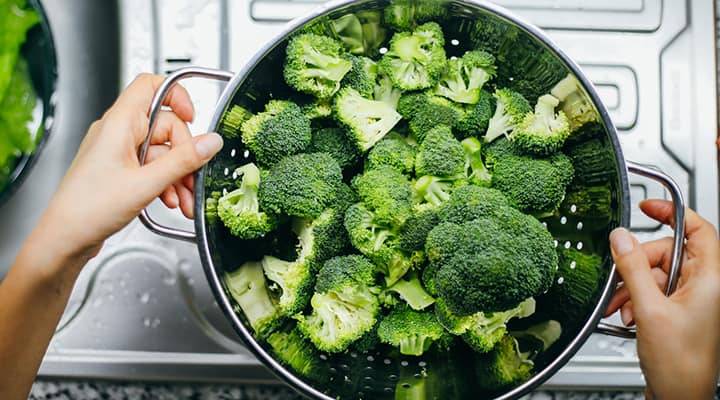
Knowing how beneficial cruciferous vegetables are to your health, maybe you're wondering whether you can enjoy them every day…or even multiple times a day. A kale smoothie for breakfast, an arugula salad for lunch, some roasted Brussels sprouts for dinner: yum!
Particularly if you're concerned about breast cancer, going into cruciferous vegetable overdrive is understandable—but, is it safe?
The short answer is: probably. There is, however, a concern is that extremely high levels of cruciferous vegetables can interfere with your body's ability to absorb iodine, which may be a problem if you have certain thyroid conditions.
Check with your doctor for guidance.
References
- Bose, Chhanda et al. "Sulforaphane potentiates anticancer effects of doxorubicin and attenuates its cardiotoxicity in a breast cancer model." PLoS One, March 2018, https://pubmed.ncbi.nlm.nih.gov/29518137/
- Dalessandri, Kathie M. et al. "Pilot study: effect of 3,3'-diindolylmethane supplements on urinary hormone metabolites in postmenopausal women with a history of early-stage breast cancer." Nutr Cancer, 2004, https://pubmed.ncbi.nlm.nih.gov/15623462/
- Erdogan, Murat Faik. "Thiocyanate overload and thyroid disease." Biofactors, 2003, https://pubmed.ncbi.nlm.nih.gov/14757960/
- Manchali, Shivapriya et al. "Crucial facts about health benefits of popular cruciferous vegetables." Journal of Functional Foods, January 2012, https://www.sciencedirect.com/science/article/pii/S1756464611000843
- Ngo, Suong N T et al. "Protective Effect of Isothiocyanates from Cruciferous Vegetables on Breast Cancer: Epidemiological and Preclinical Perspectives." Anticancer Agents Med Chem., 2021, https://pubmed.ncbi.nlm.nih.gov/32972351/
- Yuanyuan, Li et al. "Temporal Efficacy of a Sulforaphane-Based Broccoli Sprout Diet in Prevention of Breast Cancer through Modulation of Epigenetic Mechanisms." Cancer Prev Res (Phila), August 2018, https://pubmed.ncbi.nlm.nih.gov/29764806/
- Zhang, Nai-Qi et al. "Glucosinolate and isothiocyanate intakes are inversely associated with breast cancer risk: a case-control study in China." Br J Nutr., April 2018, https://pubmed.ncbi.nlm.nih.gov/29644960/
Like what you read?
Please subscribe to get email updates on this blog.

